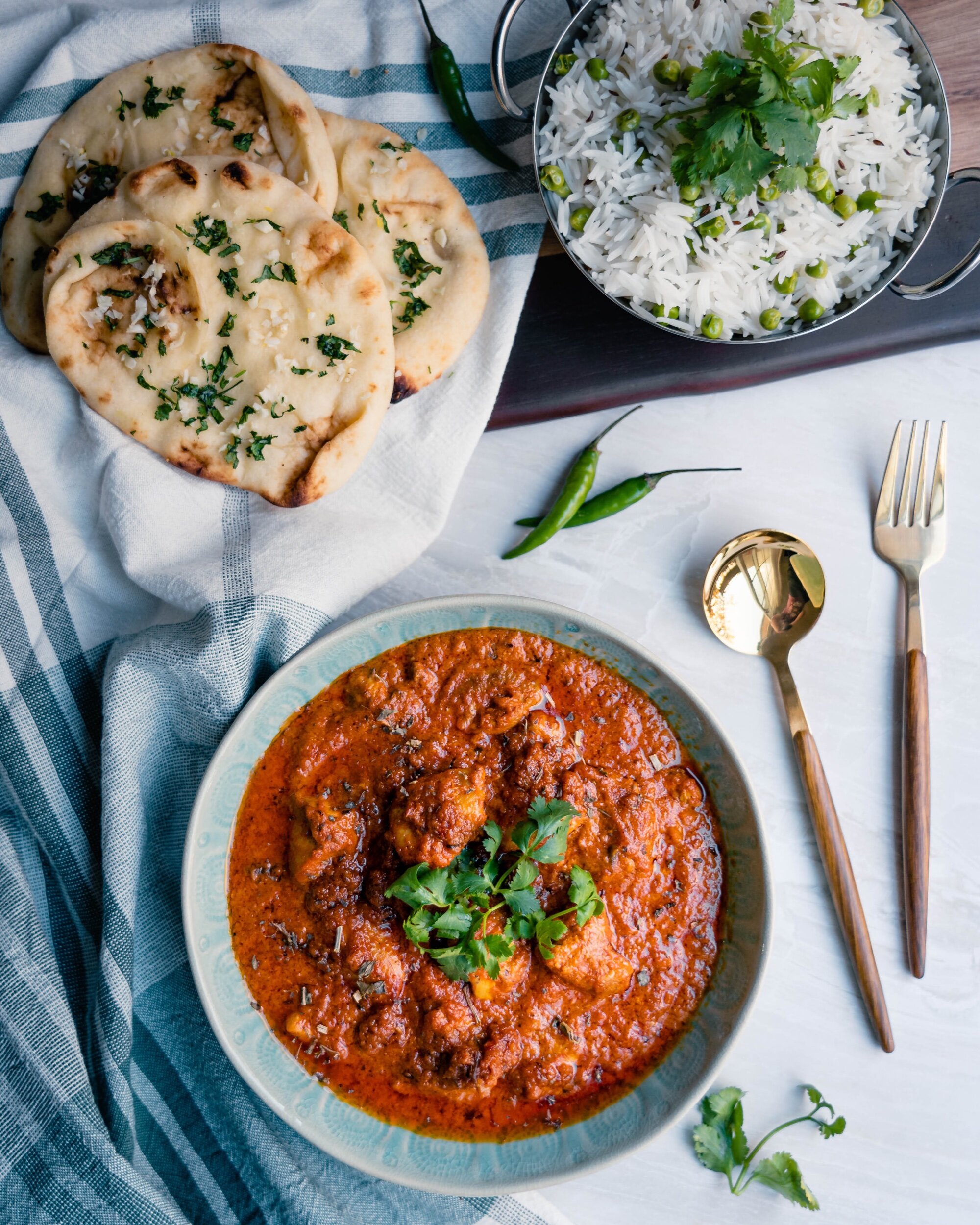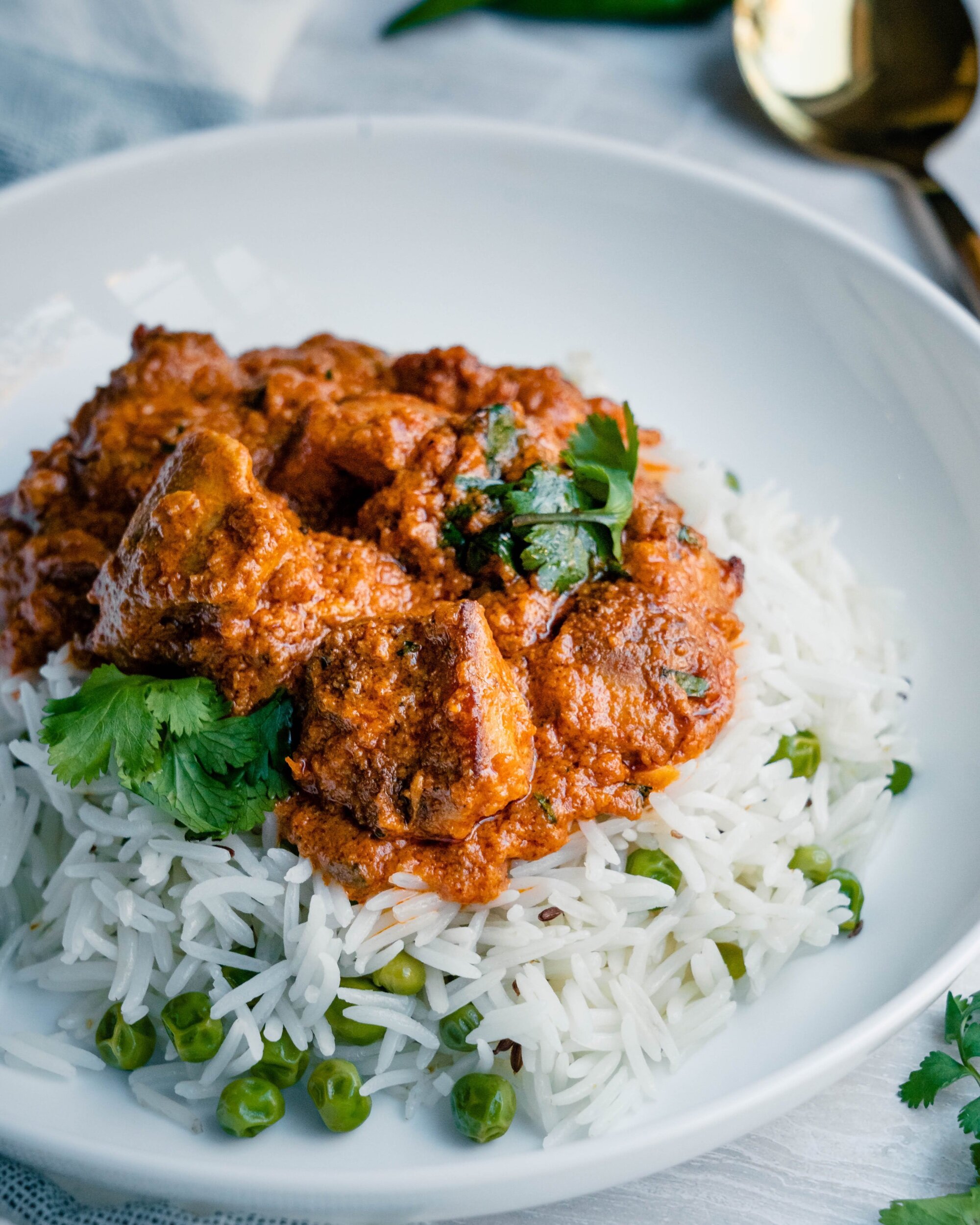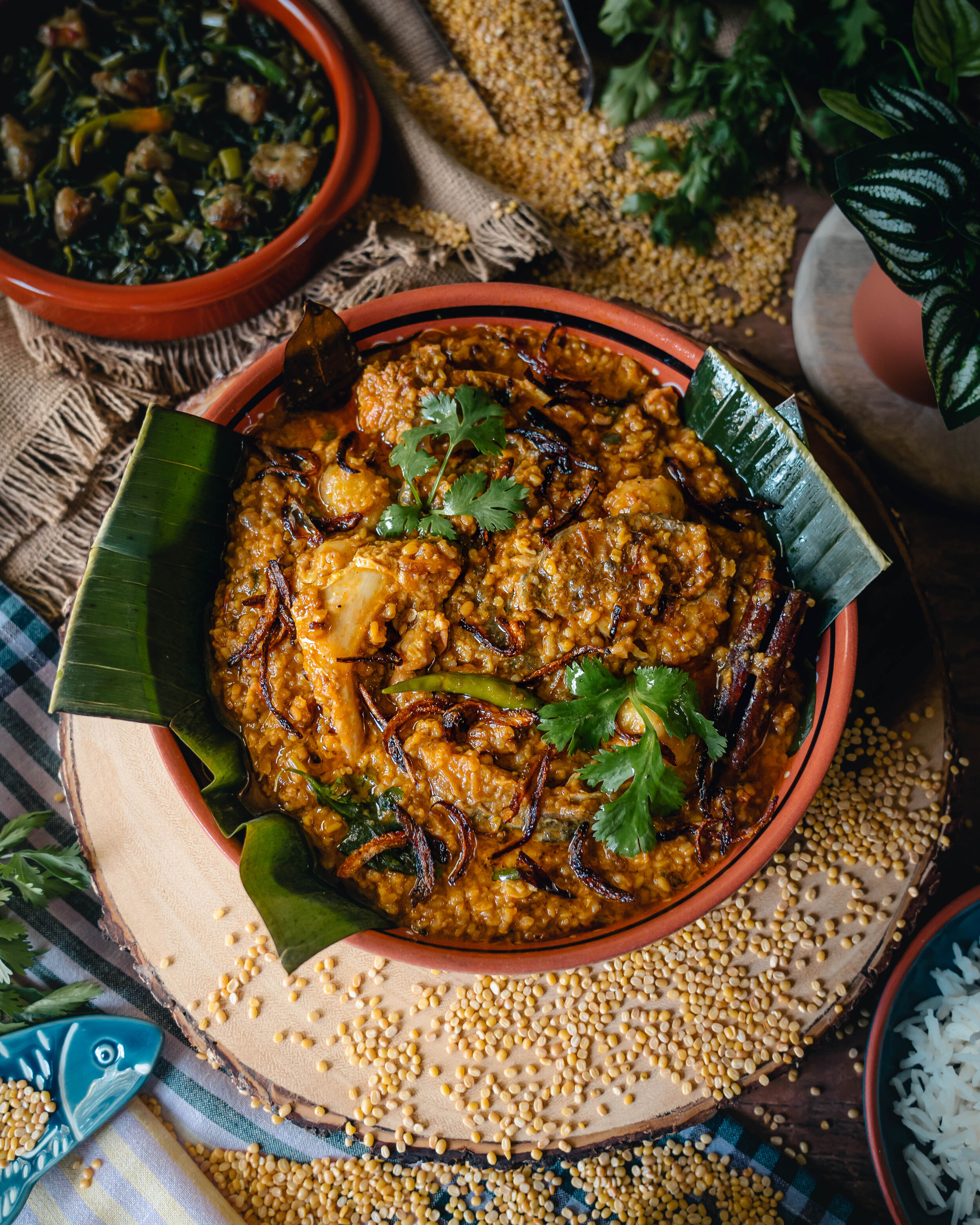Chicken Tikka Masala

There is nothing quite like sitting down to a piping hot bowl of Chicken Tikka Masala, which also happens to be Britain’s favorite dish. A sumptuous culinary wonder, with it’s smoky roasted chunks of boneless chicken, smothered in a rich creamy orange gravy. Chicken Tikka Masala is considered by foodies around the globe to be a testament to England as well as the United Kingdom’s status as a multicultural epicenter.
Chicken tikka masala or CTM as affectionately dubbed by writer Colleen Grove, is one of those culinary fables that lend a touch of intrigue and excitement to an already loved Indian cuisine in the UK. But the truth is, this dish does not hail from India. A quick digging into its history suggests it was specifically created to appeal to the British palate by some very astute local restaurateurs. In fact, many people believe it to be Britain’s unofficial national dish. If you take into consideration the history of the British empire and the post 1947 migration to the UK from Bangladesh, India and Pakistan, it makes sense why CTM has become a true British national dish overtime. It’s not because Chicken Tikka Masala is the most popular, or it was invented in Great Britain, but because it is a perfect illustration of the way the British people have absorbed and adapted to external influences and cultures. Chicken tikka masala is truly a symbol of the modern multicultural Britain.
History
The United Kingdom has a particularly strong tradition of what the general population call Indian cuisine, which in fact is a misnomer as the restaurants in question are mainly run by people of Bangladeshi origin. Chicken tikka masala was most certainly invented in Great Britain by a Bangladeshi chef and certainly does not come from the Raj or the kitchens of the Mughal Emperors. People think it’s Indian, but it’s actually Bangladeshi food which has become a staple of the British national cuisine. Until the early 1970s more than three-quarters of Indian restaurants in Britain were identified as being owned and run by people of Bengali origin. Most were migrants from East Pakistan, which became Bangladesh in 1971.
Back in the late 90s as many as 85% of the Tandoori restaurants were Bangladeshi. As of 2016, according to the Bangladesh High Commission, Brick Lane has 57 Bangladeshi-owned curry houses, and in England as a whole, around 90% of all curry houses are owned by British Bangladeshis. In the second half of the 20th century there was a burgeoning development of so-called Anglo-Indian cuisine, as families from countries such as Bangladesh, particularly people from the northern region Sylhet migrated to London to look for work. Some of the earliest Indian restaurants were opened in Brick Lane in the East End of London, a place still famous for this type of cuisine and is now popularly known as “Bangla Town”, with even the street signs being bilingual.
Indian Origin
There is a lot of different folklore surrounding this enigma of this curry dish but no Indian chef seems to have produced any real evidence that he or she first invented the dish and the recipe. There is also the fact that very few recipes for CTM can be found in the plethora of Indian cookbooks that have appeared over the last twenty years, trust me I have done my fair share of research. One thing is for certain that Chicken Tikka, as in the tandoor grilled chicken pieces itself hails from the famed Moti Mahal restaurant in India established by Kundan Lal Gujral. He first worked as a chef in a small restaurant in Peshawar, Pakistan where he experimented by skewering yogurt marinated pieces of chicken and sticking them into the tandoor, a type of clay oven which was previously used only for Breads.
In 1948, Gujral moved to New Delhi, India where he established his new restaurant Moti Mahal. He worked with a local man to produce the first restaurant version of the tandoor and even invented the tandoori spice mix. To avoid the wastage of the leftover of unsold chicken tandoori and tikkas, as well as the lack of refrigeration facilities at that time, forced Gujral to think outside of the box. And so he added tomato gravy with butter and cream to the tandoori/tikka to soften and recook the chicken, so that he can sell it again the next day. This culinary accident led to what we know today as Murg Makhni, otherwise called Butter Chicken in English. It is claimed that Butter Chicken may be the first prototype and that Chicken Tikka Masala is a toned down British version of this famous chicken curry.
Bangladeshi-Pakistani Origin?
Ethnic food historian Colleen Grove and Peter Grove, as well as journalist and restaurateur Iqbal Wahhab are certain chicken tikka masala was created in Britain, most certainly by a Bangladeshi chef. As I have mentioned before, most of Britain's Indian restaurants are owned and run by Bangladeshi chefs and there have been claims made by many that they invented CTM.
After delving deep into the depths of the numerous claims of origins, there is one widely accepted story that keeps showing up about the famous Shish Mahal in Glasgow, Scotland. The story takes place sometime in the 60s in this Indian restaurant and involves a hungry British man and a Pakistani chef, Ali Ahmed Aslam. Some news outlets claim he is Pakistani, while some claim he is Bangladeshi. My theory is that his family migrated to Scotland pre-1971 when Bangladesh was still part of Pakistan, known as East Pakistan.
Anyway, the story goes — the patron ordered a chicken tikka and he was presented with a platter of spiced, marinated chicken, but he gave the plate right back to the waiter. Turns out Shish Mahal was fashionable with the young and in-the-know of the town. But not everyone in the nation was yet familiar with South Asian food, including this particular Glaswegian patron. It was too dry for him, “in Britain, meat needs gravy or some sort of sauce, or else what’s the point”, he said. Upon hearing this, the flustered chef back in the kitchen, pulled out a can of Campbell’s tomato soup, some spices, and yoghurt, and created chicken tikka masala, a distinct and blatant fusion of British and Desi tastes and traditions. This is the most widely accepted story of chicken tikka masala, retold in anecdotes and articles time and time again.
Fast Forward
Sixty years later, South Asian food, specifically CTM has worked itself so deeply into British culture that it has become synonymous with what it means to eat British food. By 2009 Brits were consuming 25 million portions (2.5 billion pounds) of chicken tikka masala per year and 65,000 people were employed cooking and serving it. And that was just one-seventh of all the curries served in the nation. Now there’s a yearly National Curry Week in Britain, a musical number written about chicken tikka masala by a nightclub owner from Newport, Gwent in Wales, and even a tinned version sold by Heinz, you know the number one source for goopy baked beans that make up a good part of a Full English Breakfast. Actually, most of my North American readers will recognize it as the brand synonymous with Ketchup.
Anyway, here are some more fun facts about Chicken Tikka Masala
Marks & Spencer claim to sell 18 tons in a week
25 million portions a year are sold in South Asian restaurants
10 tons of it a day are produced by Noon Products destined for supermarkets
Most schools and charities in Sylhet, Bangladesh are run by proceeds from its sales
The dish has taken on a large cultural significance in Britain. In 2001, British Foreign Secretary Robin Cook hailed chicken tikka masala as a unique British innovation and the country’s true national dish. He called CTM a symbol of modern multicultural Britain and even offered his own simplified explanation of how the dish evolved: “Chicken Tikka is an Indian dish. The Massala sauce was added to satisfy the desire of British people to have their meat served in gravy.”
If you don’t believe me, go ahead and google “Britain’s national dish”. I told you so!
Recipe — Chicken Tikka Masala
Serves: 4-6
Now that we have thoroughly discussed the history, existence and the global demand of CTM, how is it exactly made?
Well, tikkas are bite sized chunks of boneless chicken that are marinated and cooked in a tandoor aka the famous Indian clay oven. The masala part is where things start to diverge. Masala just means spices but no exact recipe for this seems to be unanimous. The masala gravy part of CTM can be orange, yellow, red, brown heck even green and it can be very creamy, a little creamy, chili hot or quite mild and sweet. In authentic restaurants it tends to be a creamy sauce - not too hot, a bit tomato-ey, very smooth gravy and quite often sweet ranging from orange to red color. I once read somewhere that there are more than 50 different versions of this dish and I am going to share with you the @TheSpiceOdyssey version today!
Chicken Tikka | First Marinade
Chicken Thighs - 2 lbs, cut into bite size pieces
Lemon - half, juiced
Salt - 2 tsp
Kashmiri Red Chili Powder - 1 tsp
Place the chicken pieces in a large bowl and toss with salt, lemon and chili powder. Let the chicken sit at room temperature. After about an hour, drain the water that has pooled up in the bottom of the bowl. Set the chicken pieces aside.
Chicken Tikka | Second Marinade
Ginger-Garlic Paste - 2 tbsp
Kashmiri Red Chilli Powder - 1.5 tbsp
Garam Masala - 1 tsp
Cumin - 1 tsp
Coriander - 1 tsp
Black Pepper - 2 tsp
Kasoori Methi - 1 tbsp
Lemon - half, juiced
Yogurt - ¼ cup
Oil - ¼ cup
In a separate bowl, whisk together all of the ingredients above. Toss in the chicken pieces to coat, then cover and refrigerate for at least 6 hours, preferably overnight.
…
Note: This is a two stage marination process. The purpose of the first stage is to let the chicken lose a certain amount of water which in turn will ensure the tikka/tandoori is not insipid and watery. This is important especially if you are cooking it on stovetop or baking it in the oven instead of grilling it in the barbie or a tandoor (who the heck has a wholea** clay oven in their home?!) This process also helps the marinade from the second stage penetrate and adhere to the chicken pieces better. The second stage is all about the flavor and how you like your tikka or tandoori to be.
Double marination is key to making juicy chicken tikka and tandoori. This is how I have been making chicken tandoori for years and years. My tikka/tandoori turns out great every single time because of this nifty little trick (plus my own personal spice mix, more on that another day). And in my family I am the queen of tandoori, I know because it’s something my mom, aunts and my in laws request me to make/bring, whenever I am around and they are entertaining guests.
Chicken Tikka | Cooking the Chicken
The next day (or 6 hours later) bring out the chicken from the fridge. Let it come to room temperature — this should take about 30 minutes to an hour.
Heat the oven to 450°F. Grease a rack fitted in a sheet tray with butter and place the chicken on the rack. If the chicken pieces are smaller, thread them onto skewers and then place them on the rack. Roast chicken evenly on all slides until juices run clear, approximately 10 to 15 minutes. Then broil for 5 minutes in 500°F — this will ensure the chicken develops a nice brown and flavorful crust.
Once the chicken is cooked, set it aside and cover loosely with foil. Save all of the pan drippings to be used for the masala gravy later.
…
Note — You can also grill the chicken pieces in a barbecue or cook it on the stovetop. If you prefer the stovetop method, try to use a wide skillet so the chicken pieces aren’t cramped together and the water released quickly evaporates as they cook. Also, try not to overcook the chicken because this is only the first stage of the cooking process. The second stage, the cooked chicken pieces will be simmered in a masala gravy.
Essentially, the chicken will undergo 4 different stages of curing and cooking - first marinade, second marinade, roasted/grilled and then finally simmered/poached in the gravy. Issa chicken-ception.
The Masala | Tempering the Spices + Aromatics
Ghee - 2 tbsp
Oil - 2 tbsp
Cumin Seeds - 1 tsp
Clove - 2
Cardamom - 2
Dried Whole Chile - 2, deseeded
Heat up oil and ghee in a large skillet over medium-high heat. Once the oil is hot, bloom the spices, about 1-2 minutes. The dry spices should crackle but make sure not to burn them.
Note: If you prefer your CTM to be on the sweeter side, discard the seed from the dried red chili or just omit it altogether.
Onion Paste - half cup
Ginger-Garlic Paste - 2 tbsp
Add the onion paste and stir fry until they go from white to a pale yellow translucent color, about 8-10 minutes. Add the ginger-garlic paste and continue to saute for another 5 minutes.
Kashmiri Red Chilli Powder - 2 tsp
Cayenne - 1 tsp
Paprika - 1 tsp
Garam Masala - 1 tsp
Cumin - 1 tsp
Coriander - 1 tsp
Turmeric - ½ tsp
Salt - 2 tsp
Add all of the spices above and continue saute-ing until the smell of raw onion, garlic and ginger dissipates, about 10-15 minutes. The spices mixed with the onion-ginger-garlic paste should go from light yellow red color to a more pronounced fiery orange red. You will know it’s ready when the raw smell is completely gone, there is a nice aroma and oil starts to pool up around the spices.
…
Note: This is a critical step in South Asian cooking. We call this “tarka” which basically means tempering and roasting of whole spices, ground spices and aromatics in oil or ghee to liberate essential oils from their cells, which enhances their flavors and in turn the flavor of the dish. Think of it as the South Asian version of Spanish Sofrito, French Mirepoix and Cajun-Creole Holy Trinity. If you fail to do this step, then you have failed to make your curry correctly. Sorry for being such a controlling and strict South Asian mom but you just got yourself a big fat zero in this paper. I’m joking, but try not to mess this up. You will understand when you can visibly see and taste the difference in the final form.
The Gravy | Bringing It All Together
Tomato - 4, chopped
Cilantro Stems - ¼ cup
Indian/Thai Green Chilies - 2-6, if you can’t handle spicy food, start with 2
Tomato Paste - 2 tbsp
Chicken Pan Dripping
In a food processor or blender, combine tomato, cilantro stems and fresh green chilies and blend until the mixture turns pulpy. Add the tomato mixture, tomato paste and the chicken pan dripping to the spice mixture in the skillet. Taste for salt, stir frequently and bring everything to a boil. Cover, reduce the heat to medium-low, and simmer gently for 15–20 minutes. The sauce should turn thick, turn darker in color and oil will emerge on the surface of the gravy.
Honey - 1-2 tsp
Heavy Cream - ¼ cup
Hot Water - ½ cup
Cooked Chicken Tikka
Stir in the honey, cream and hot water. Let the gravy come to a boil, then fold in the chicken tikka pieces. Simmer gently for another 5-10 minutes until the gravy is to your desired consistency.
Roasted Garam Masala - 1 tsp
Roasted Cumin Powder - 2 tsp
Kasoori Methi - 2 tsp
Coriander Leaves
Add garam masala, cumin powder and kasoori methi and taste for salt. Combine well and then turn off the heat. Top it off with fresh coriander leaves. Serve with steamed Basmati Rice and Garlic Butter Naan.













